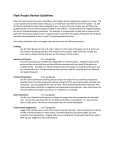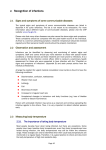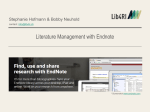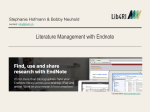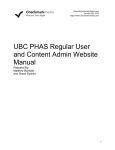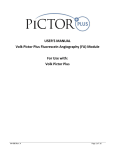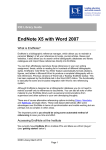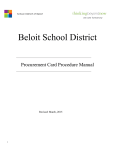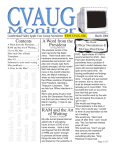Download Here
Transcript
Journal article style thesis Main Introduction [Literature review - optional] Objectives Chapter 1 (Article 1) – Introduction (shorter than above) – Objective(s) – Methods (more detailed than for journal article) – Results and discussion (and brief conclusions) Journal article style thesis Chapter 2 (Article 2) – Introduction (shorter than above) – Objective(s) – Methods (more detailed than for article) – Results and discussion (and brief conclusions) Chapter 3 (Article 3) – …. Chapter 4 (Overall Conclusions) References Appendix Organizing Organize by objectives Talk with your major professor before you start to write Look at other recent theses/dissertations Choosing a Journal Appropriate to content of article – Have similar topics been covered in that journal? Similar length? What audience do you want to read your article? What is the role of “prestige” in journal selection? Regional, national or international? Is timeliness important? Page charges? Other considerations? Journal article outline Title page Abstract page Introduction – Objectives Methods – Field experiments – Lab experiments Results and Discussion – Field experiments – Lab experiments [Conclusions] Title May be the only thing people see. Shows up in: – Literature citations – Literature searches – Your vitae Essential that it be: – Informative – Specific – Appropriate for the audience Writing a title List key words Chose the most important key words Be specific Be complete Put important words first – (e.g., not “effects of” or “observations on”) Writing a title (continued) Use common name of insect if it’s an Ent. Soc. of America journal (see journal for examples) – Give order and family Otherwise, generally use scientific name – With some descriptive word or words (e.g., the carabid beetle Bembidion quadrimaculatum) Introduction Two goals – Give readers background so they can understand the problem and the paper – Clearly state the problem and objectives Broad beginning - start at a level that most or all readers already know Introduce the main focus or foci – e.g., tell about your insect – Introduce your ecological system Introduction Start broad and narrow down to objectives Perhaps give goal or goals (broad, long term) Specific Objectives - final paragraph Objectives should be specific enough to define the experimental methods [Some authors and journals include brief methods and results in the Introduction] Scientific names Always cite the full scientific name and author the first time it is used in the abstract and again in the introduction – Genus, species, author After that, the name can be abbreviated as G. species If other species in the same genus have already been listed, still give the full genus name the first time. Citations Generally put citations at the end of the sentence or the end of the thought – Blah, blah, blah (Smith and Jones 1998, Murray 1999) Do not list authors as part of the text unless authorship is important (e.g., breakthrough research, unusual results) – Smith and Jones showed for the first time that blah blah (1998) Citations, continued (PROC GLM, SAS Institute 2001) for software user's manual in text. In reference list: – SAS Institute. 2001. PROC user's manual, version 6th ed. SAS Institute, Cary, NC. List citations in chronological order » (Jones 1997, Brower 1999) Personal communication – (L. J. Smith, personal communication) – Letter or email documentation required by editor Citations, continued Unpublished data (your own) – (unpublished) – (E.G., unpublished) Articles that have been accepted for publication – Smith (in press) Web sites – By author or “anonymous” – List site and most recent date accessed References cited See Day and Gastel chapter 15 See your specific journal – Follow those guidelines exactly Keep a full list of references – condense or format (number order, etc.) during the last revision before submitting – Keep this full reference list for future use Use Zotero, End Notes, etc. References cited (after final revisions) Review all references in text to be sure they are cited in References section Review all references in Ref Cited section to be sure they are in text [This is tiresome but important] Present vs. past tense in citing previous work What someone did is past tense: e.g. “Smith and Jones (1998) measured black fly populations in streams.” Accepted knowledge is present tense: e.g., “Black flies inhabit streams (Smith and Jones 1998).” If their results were a special case: “In their study, Smith and Jones (1998) found black flies in streams. However, Brown and Cummins…” For your results, use past tense: “We found black flies in streams.” See Day and Gastel p. 191-193 Acronyms/Text abbreviations Acronym - a word formed from an abbreviation Text abbreviations (DNA) – Do not use abbreviations, if possible » Confuses the reader » Disrupts reading and interpretation process – Use abbreviations if they are commonly accepted in your field » DNA, PCR, IPM, etc. – Spell out and define the first time in Intro and in Abstract Writing Blocks A barrier to free expression of ideas on paper - just can’t get going or keep goingSymptoms – – – – – Procrastination Anxiety Guilt Restlessness Missed deadlines Why do you get blocked? – Technical problems – Internal critic Everything I do starts out a mess. You’d be embarrassed to have anybody look at it. And you just have to sit with it and push it around- and throw half of it out, and take the other half and mush that around a little bit. It just takes time. Most people just give up. Garrison Keeler, A Prairie Home Companion Writing Blocks (continued) Unblocking at: – Writing the rough draft » Seize a creative moment » Make a writing appointment Pick a time of day that is “up” for you » Get started and keep going Turn off your inside critic » Non-stops - short timed start and stop Writing Blocks (continued) » Don’t get side-tracked by… Telephone, email Need a specific reference, spelling Finding the perfect words » Put in notes or reminders and keep going“ …here I need to say something about xxx…” Writing Blocks (continued) Unblocking at: – Revising and polishing » Now you turn on your “critic” » Take a break after writing and before revising » Put in your references, check spelling, fill in reminders » Change the medium (computer to print-out, different font, ?) » Read aloud » Keep previous drafts (e.g., v1, v2, etc.) » Get a friend to review and discuss Revision process First – Look for overall organization, outline, logical progression » Does the introduction lead the reader down to objectives » Is any information left out » Is there too much on a topic? – Are there good transitions between paragraphs? – Insert/delete/move paragraphs or sections Revision process Second – Go back and do minor revisions » Paragraph and sentence structure, spelling » Fill in references, data, etc. » See Day “Words and expressions to avoid” » See your journal style manual Finally – Review again for overall structure, flow, details, etc. Revision/Reviewing Do you ask a friend or co-worker for comments on a paper you wrote for a class? – Why not? What can other readers tell you about your writing? What if the reader is just stupid? Doesn’t get it? Set up a “partnership” for reviewing each others’ writing Revision/Reviewing What about reviewing/critiquing papers for this class? – Review writing structure, style, format, etc. – Not a class where we do an evaluation of the science, experimental design, statistics, etc. Revision/Reviewing Reviewing in a positive manner – Use “I messages” e.g., “This is unclear to me”, “I am having difficulty with this”,… Not, “You really screwed up here”, “You wrote this badly”, “This part sucks!” – If something is unclear, offer a suggestion about how to fix it – Explain why you make the suggestions/comments Revision/Reviewing Accepting reviews – Try not to take anything personally – It’s a part of any writing process – Remember that others in your group have as many problems with their writing as you do. – Ask for details about why a section is confusing or why something was misinterpreted – Don’t get defensive -- “Anyone with a brain could understand this. It’s perfectly clear.” Assignments Readings (Day and Bastel) – General topics (Chapters 1-6) – Title (Chapter 7) – Authorship (Chapter 8) – Introduction (Chapter 10) Title and Introduction – Due to your group, Matt, and Ed by Jan 27 – Small groups meet the week of Feb 1 Mind Maps - bring to small group meeting






























